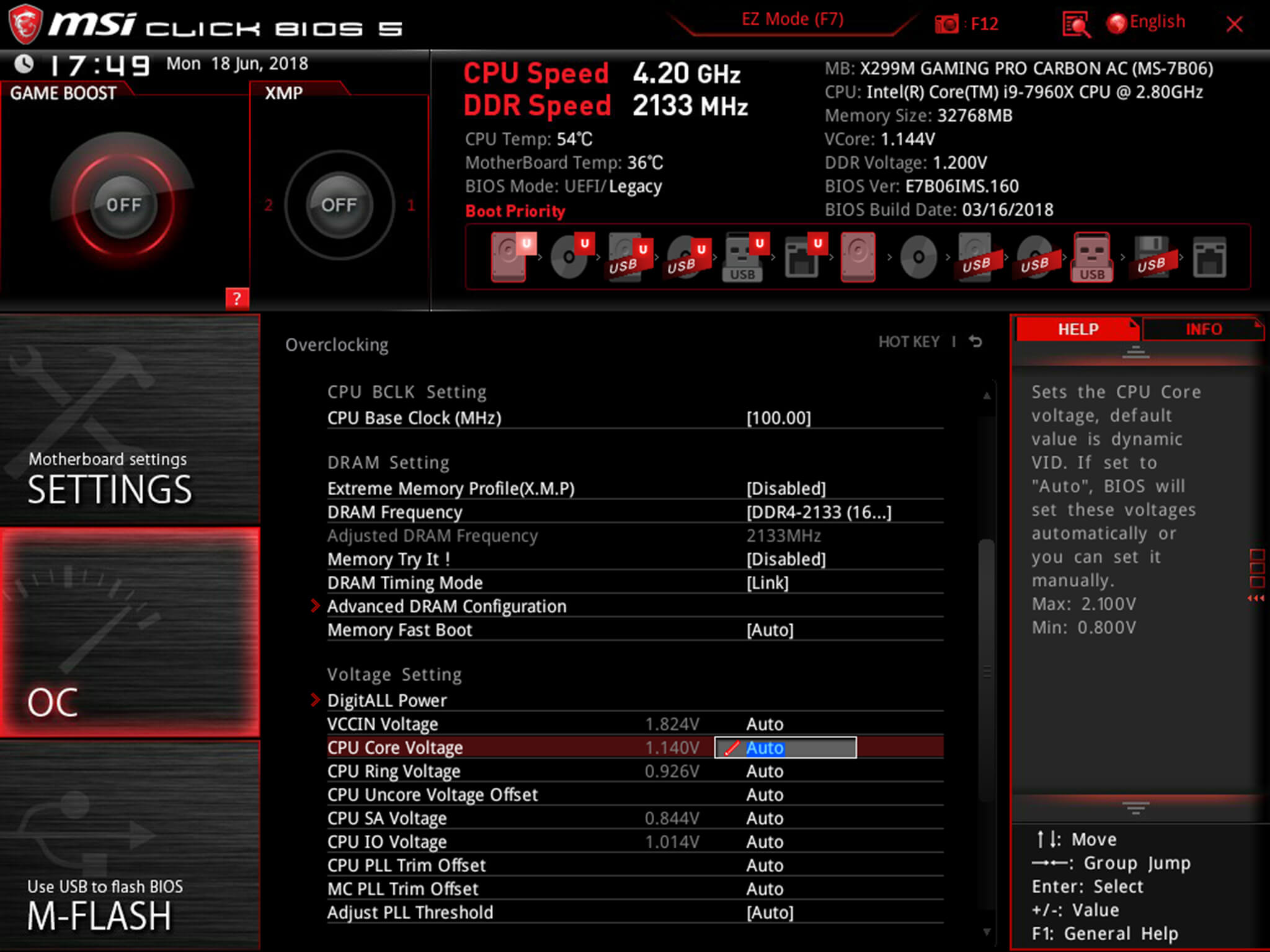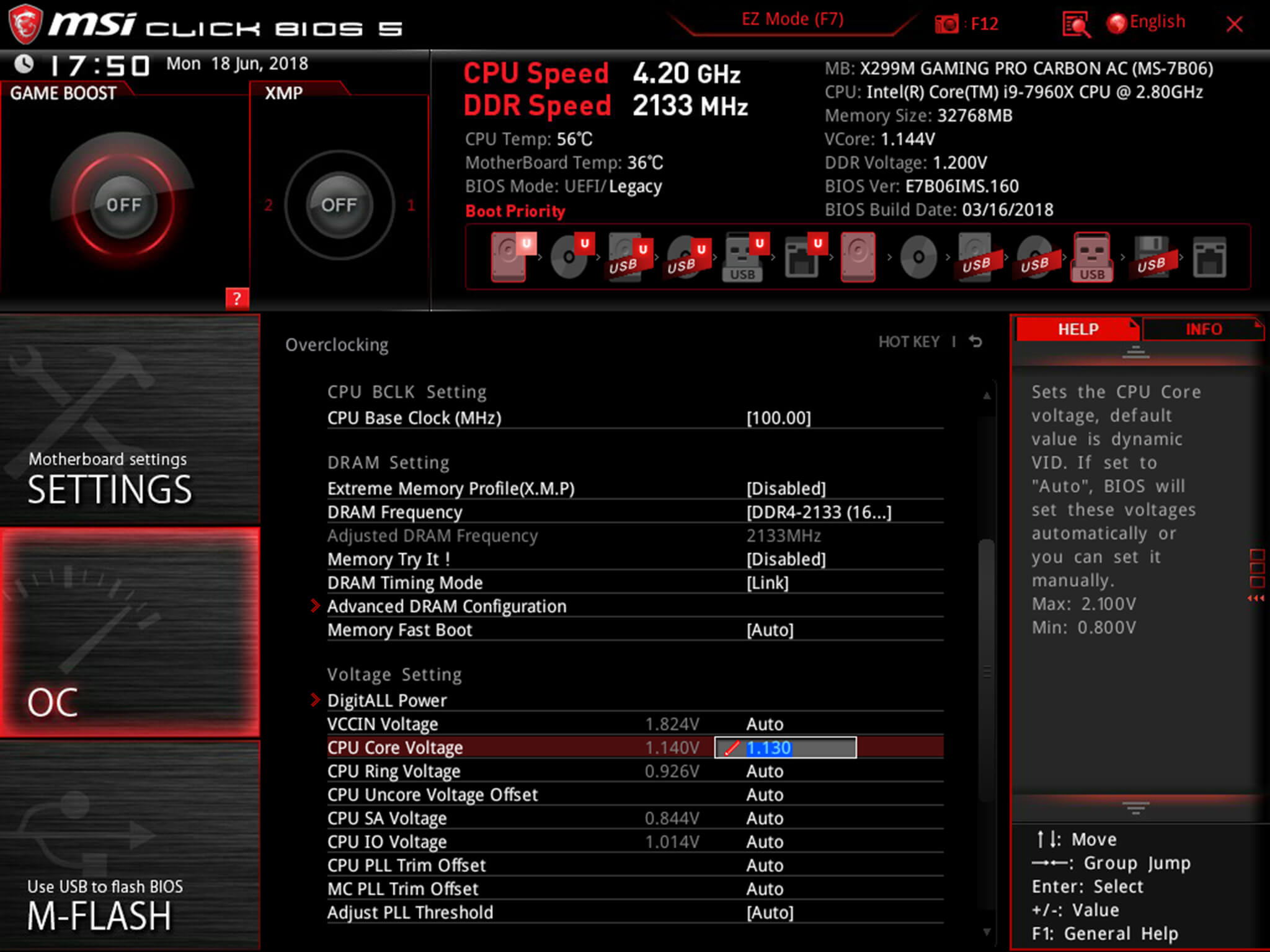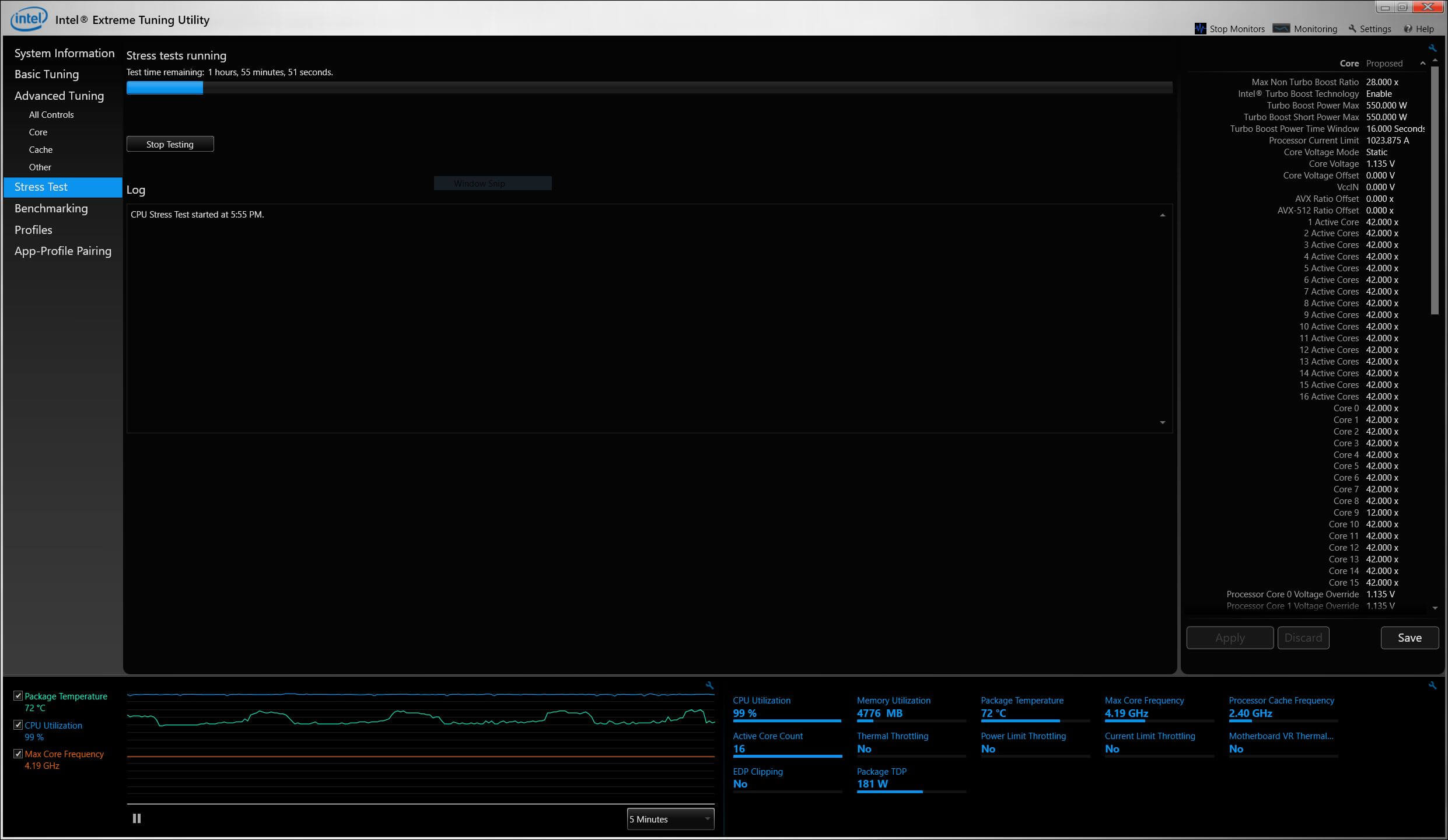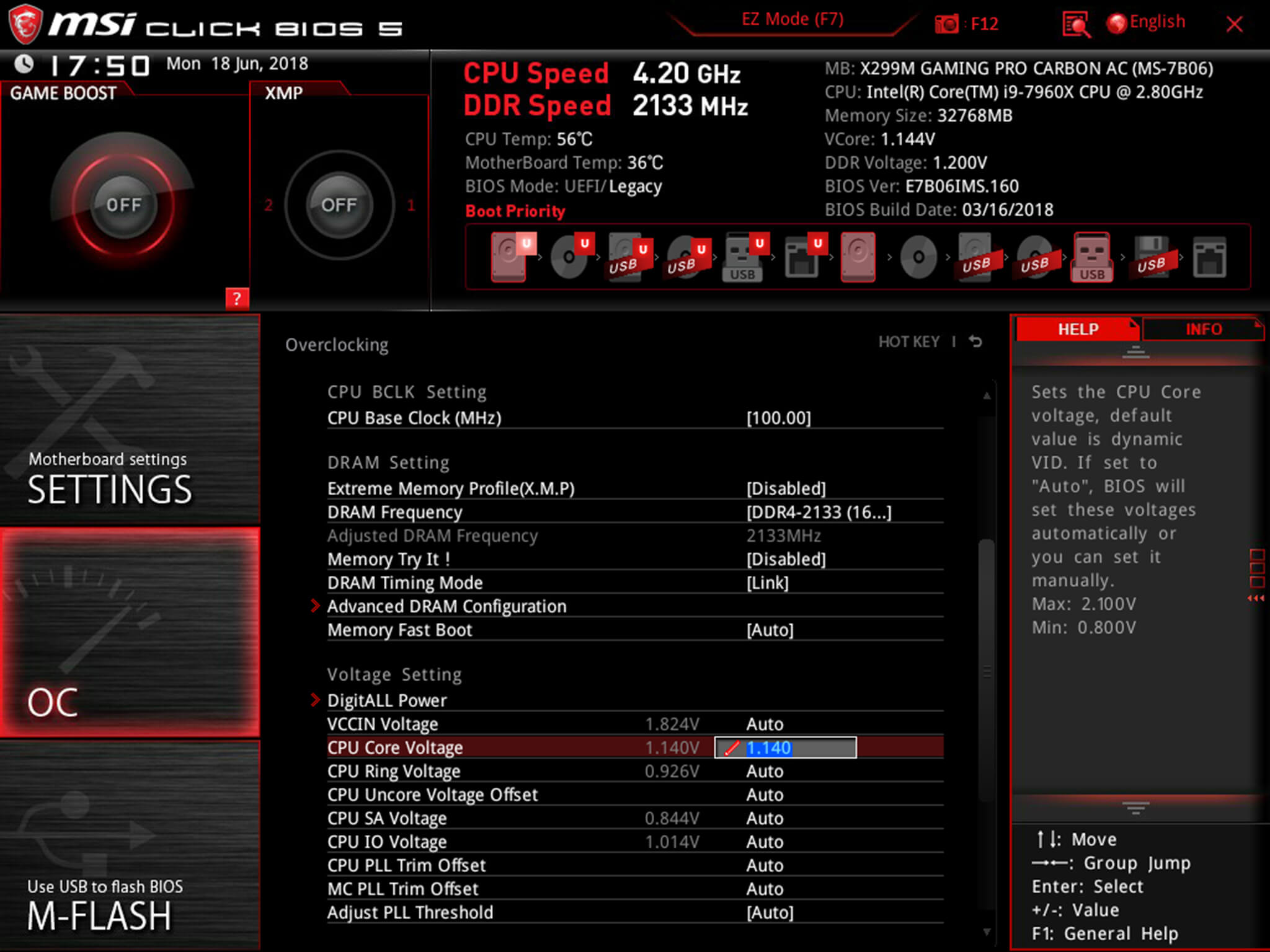The core voltage is different for each processor model, and while all CPUs of the same model have the same VID, not all samples maintain stability at the same clock speeds and Vcore due to slight variations in silicon quality. Every sample of the same CPU model is tested to maintain stability at the default speeds and the VID determined by the manufacturer.
Core voltage typically maintains a constant value while your CPU is in use; however, sometimes under heavy workloads vcore can fluctuate. This is known as Vdroop and can be corrected with load-line calibration. This applies additional voltage as load increases to maintain your CPU's stability.
When it comes to overclocking, you can only push your CPU's frequency so far before your CPU starts to experience instability. Programs might begin to crash or hang up, game performance could suffer or your computer could even fail to boot. This is because your processor isn't getting enough voltage to maintain system stability.
Increasing voltage will allow you to dial in the perfect overclock.
To adjust the voltage, you'll need to boot into your motherboard's BIOS and make adjustments there. The Vcore is expressed as a three decimal value, such as 1.235v. By default, the voltage control is set to auto; this can be overridden by typing in any value. Make sure not to exceed the recommended maximum for your processor.

Before fine-tuning the Vcore, it's important to find a good baseline value for a given speed. This varies from model to model but it can be helpful to read reviews for your CPU, specifically ones that focus on overclocking.
Most publications will list the voltage they required to keep several different speeds stable. Every CPU sample is different and you will need to fine-tune the voltage before calling it done; however, these values do provide a good starting point.

If you boot your machine and don't find any stability issues, then you know it's time to start decreasing the voltage. When overclocking, you want to find the lowest voltage required to maintain stability. More voltage equals more heat and this will allow you to keep temperatures under control.

The safest way to adjust voltage is with increments of .01 volts. Decrease voltage until your computer starts showing signs of instability under load. Use a program like Intel's Extreme Tuning Utility (XTU) or Prime95 to stress test your processor.
If the test fails or crashes, then you need to raise the voltage back up to the previous stable point. For optimal efficiency, you can increase the voltage by .005 instead and again test for stability.

Conversely, if your overclock isn't stable at your baseline voltage, you will then need to increase the voltage until your computer shows no adverse effects and then decrease in increments of .005 to fine tune.

Overclocking is not the only time it can be useful to adjust voltage. As mentioned, higher voltage levels cause your CPU to generate more heat, regardless of frequency. Some CPU samples may have a higher VID than is actually required at the default frequency. Undervolting your processor allows your to maintain stability while decreasing temperatures and extending the life of your processor.
It's a common misconception that disabling Turbo Boost is a more effective substitute for shedding heat. While this does result in decreased temperatures, it is not an alternative as the purpose of undervolting is to maintain the same level of performance while generating less heat. When making adjustments, the same principles apply here as with overclocking, decrease Vcore in increments of .01 and then fine tune with adjustments of .005.
(Editor: {typename type="name"/})
 Amazon Big Spring Sale 2025: Best deals under $50
Amazon Big Spring Sale 2025: Best deals under $50
 New Orleans Santa Claus inspires the best Twitter thread of the holiday season
New Orleans Santa Claus inspires the best Twitter thread of the holiday season
 Grayson Allen and the arrogant sanctimony of Duke's Coach K
Grayson Allen and the arrogant sanctimony of Duke's Coach K
 No mercy: Facebook page held hostage in payment dispute
No mercy: Facebook page held hostage in payment dispute
 Best iPhone deal: Save $147 on the iPhone 15 Pro Max
Best iPhone deal: Save $147 on the iPhone 15 Pro Max
Best rope light deal: Save 25% on Lepro N1 AI Smart RGB LED Strip Lights
 SAVE $14.99: As of April 15, Lepro N1 AI Smart RGB Rope Lights are available for $44.99 at Amazon. T
...[Details]
SAVE $14.99: As of April 15, Lepro N1 AI Smart RGB Rope Lights are available for $44.99 at Amazon. T
...[Details]
Total stranger pays for woman's Christmas presents after her card was declined
 LONDON -- Whether you love it or loathe it, Christmas brings out the best in all of us. It's a time
...[Details]
LONDON -- Whether you love it or loathe it, Christmas brings out the best in all of us. It's a time
...[Details]
Rockettes can skip the inauguration, thanks to the internet
 Just as it was starting to seem like no one would agree to perform at Donald Trump's presidential in
...[Details]
Just as it was starting to seem like no one would agree to perform at Donald Trump's presidential in
...[Details]
Facebook's not alone: Twitter admits to overcharging advertisers
 On the heels of several embarrassing metric error disclosures from Facebook, Twitter is taking its o
...[Details]
On the heels of several embarrassing metric error disclosures from Facebook, Twitter is taking its o
...[Details]
Researchers map the koala genome in the name of saving the species
 Koalas, the tree-dwelling marsupials found in eucalyptus forests and woodlands across Eastern Austra
...[Details]
Koalas, the tree-dwelling marsupials found in eucalyptus forests and woodlands across Eastern Austra
...[Details]
The 16 most bogus movie stories of 2016 (and how to spot them)
 "Fake news" had its shining moment on the political hill in 2016, but anyone who’s been around
...[Details]
"Fake news" had its shining moment on the political hill in 2016, but anyone who’s been around
...[Details]
Grayson Allen and the arrogant sanctimony of Duke's Coach K
 Before we really begin here, let's briefly look back to March. Oregon had just eliminated Duke from
...[Details]
Before we really begin here, let's briefly look back to March. Oregon had just eliminated Duke from
...[Details]
8 weird things Indians did in 2016 to get into Guinness World Records
 India, the second most populous nation in the world, is full of quirks and eccentricities. Here are
...[Details]
India, the second most populous nation in the world, is full of quirks and eccentricities. Here are
...[Details]
Bargaining For the Common Good
 Interviews for Resistance
...[Details]
Interviews for Resistance
...[Details]
Double parker receives shoppers' wrath in the form of shopping carts
 Everyone who has ever driven a car can agree that people who park over the line are the worst.One dr
...[Details]
Everyone who has ever driven a car can agree that people who park over the line are the worst.One dr
...[Details]
Nintendo Switch 2 release date, price announced

Ridiculous man recreated a classic 'National Lampoon' scene for a good cause

接受PR>=1、BR>=1,流量相当,内容相关类链接。